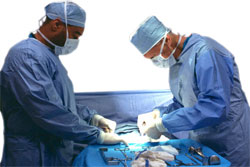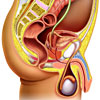- Introduction to treatments for prostate cancer
- Treatment options for prostate cancer
- Which treatment is for me?
Introduction to treatments for prostate cancer
New treatments are on the block for prostate cancer of a number of sorts claiming reductions in side-effects – but are they really better at achieving the goal of curing cancer?
Prostate cancer is a very common cancer in men who have this tiny gland located just under the bladder and encircling the urine tube (the urethra).The frequency of this disease is skewed towards the very elderly – in fact, a common saying is that many patients with prostate cancer will die with their condition rather than from it. Surprisingly, it has been found that in men in their 80s, there are often tiny unsuspected islands of microscopic prostate cancer present inside the prostate that have caused no symptoms in over a third of men. However, there are higher grade (more aggressive microscopic appearance) cancers, and some men develop prostate cancer in middle age.
Because of these different forms and age groups of prostate cancer, it is not hard to understand that using the most powerful surgical and other treatments on, say, a very elderly man with a low-grade indolent cancer who is unlikely to progress to symptoms, might be like using a sledgehammer to kill a gnat! On the other hand, a young patient may need one or more aggressive treatments.
Prostate cancer has several other special characteristics. Another is that, because the male prostate gland cells are normally made to grow into a gland by the influence of the male hormone, testosterone, that prostate cancer growth is itself often dependent on the presence of male hormones. This means that an effective variety of injections, tablets, and procedures designed to stop the effect of testosterone, may often stop the growth of prostate cancer for months to years by themselves. This may mean that the only treatment necessary for some older men over 60 or 70 is hormonal therapy, achieving useful control of the cancer, without the potential risks of surgery, not even needing to operate on the cancer itself. So, the prostate treatments advisable are often different for men over 60.
Another useful characteristic of prostate cancer is that the progress of treatment can be readily assessed by a simple blood test called the PSA test (prostate specific antigen). This allows watching and waiting to assess the effects of one treatment before deciding on another if necessary. For the younger middle aged patient, generally more aggressive treatment is needed and more than one type of treatment may be used together.
Treatment options for prostate cancer

Active surveillance (watchful waiting)
Certain slow-growing tissue types of prostate cancer, especially in older men, may safely be watched, say, with six monthly PSA lab tests and yearly needle biopsies (tissue samples of the prostate).
Radical prostatectomy (surgical removal of the prostate)
Like the appendix, humans don’t actually need a prostate. The most established traditional treatment to cure and eliminate prostate cancer permanently when it is localised inside the prostate is to remove it.
The potential disadvantages to surgery is the possibility of the three Is – impotence, incontinence and infertility. Incontinence, with modern substantial improvements in surgical technique, is now at very low rates – about 2% of patients.
It is hard to beat this operation in the hands of an experienced prostate surgeon who has a track record of low positive (cancer left behind) margins, high continence results, and high potency (sexual functioning) results, but there are a host of new variations on this operation making new claims, in some cases with limited experience and with less encouraging results than initially thought.
These include:
- Nerve sparing surgery: May enhance erections but may leave tumour behind, as prostate cancer commonly invades nerve sheaths.
- Grafting a leg (sural) nerve into the prostate area: A new procedure in the last five years with less encouraging results than initially appeared for the same reason.
- Keyhole laparoscopic surgery: Laparoscopic surgery is done by some surgeons which may limit access and visualisation of extensive prostate cancers or unsuspected haemorrhaging.
- Robotic surgery: More difficult in situations of a very large prostate, where there is cancer in the middle lobes of a prostate; very overweight patients; advanced prostate cancers; and cancer at the base of the prostate. It is a new technology and as with any new technology, experience is required to gain the excellent outcomes of a very experienced surgeon using an established technique. An advantage of laparoscopic or robotic techniques would be a small scar with an earlier discharge from hospital.
An important advantage of surgery is that if further prostate cancer is later detected, further treatment is still possible. By comparison, if radiotherapy techniques are used, they cause local scarring and thinning of organ tissues, which may prevent effective surgery later.

- Brachytherapy: Involves placing radioactive pellets inside the prostate to allow very high doses of radiation to kill the cancer being delivered to a very small area, in an attempt to limit radiotherapy damage to adjoining structures such as the bowel and bladder and associated risks of developing a radiation related second cancer. It may have a place for only a few patients with very early cancers, and a PSA blood tests less than 10. The potential benefit is a good result with retained sexual functioning. As mentioned, treatment options are limited if an attempt at this therapy fails.
- Conformal radiotherapy: This is a focused external beam. Some techniques such as tomography are not available in Australia. Conformal radiotherapy allows the delivering of very high doses of radiotherapy, which is necessary to eradicate tumours when the PSA is higher than 10, with low side-effects. As mentioned before, treatment options are limited if the therapy fails. It may have a place in some elderly patients.
High intensity focused ultrasound (HIFU)
High intensity focused ultrasound (HIFU) is another new technique which uses intense heat applied through the rectum by an ultrasound to destroy the prostate and cancer if localised within the gland. Only five years experience is currently available to assess this option at this stage. It is still unknown whether this technique will prevent other surgical techniques from being used if an attempt at this therapy fails.
The side-effects are obstructed urine flow, which can be prolonged, and infections, and relatively high rates of impotence.
It is one of the few therapies that can be used after radiotherapy has failed. It may be suitable for a few patients who have otherwise short life expectancies and have exhausted or refused other preferable treatments.
Which treatment is for me?

- The type of cancer: Is it contained within the prostate? Has it spread beyond the prostate?
- The activity level (grade) of the tumour: Is it slow-growing and low-grade, or does it have high-grade characteristics under the microscope which mandate more aggressive treatment?
- Age: The younger you are, the more likely the tumour will become an overt problem if not aggressively treated.
- Your concerns about side effects: Your worries about side effects of treatment, including impotence, incontinence or infertility, or some preconceptions based on what acquaintances have experienced, or even a liking for new technology may be concerns. Of course, the only way to risk no side-effects is to have no treatment at all, which would be a potentially fatal choice.
Care therefore must be taken in weighing up whether you would wish to have these preferences taken into account by your treating urologist – would you wish to shorten your own survival because for example, if you wish to retain erections?
There are a number of surgical implants which could later, when you are cured, be used to obtain erections. You must be clear when instructing your specialists where survival is your major priority over and above the concerns of side-effects, of one type or another. Otherwise your surgeon may make choices based on your concern, say about sexual functioning such as avoiding surgery, which may subsequently increase the risk of leaving cancer behind.
Similarly, a preference expressed for ‘natural therapies’ may prevent the option of surgery altogether. Another useful question to ask may be how any side-effects can be treated once the ideal treatment for cancer is over, and your treating specialists will be able to help you with this. As always, a degree of caution is necessary about newer treatments that have been used for cancer for less than 10 years as this is a short time in the cycle of cancer treatment and cure.
You also need to decide whether you want to make the treatment decisions or whether you would prefer your treating specialist to recommend the best course of action to take.
Kindly contributed by Associate Professor Phillip Stricker MB BS (NSW) (Hons) FRACS; Conjoint Associate Professor UNSW, Chairman Department of Urology, Urological Surgeon, Uro-oncologist, Prostate Cancer Specialist.
More information
 |
For more information on prostate cancer, including diagnoses, types of treatments, and some useful tools, videos and animations, see Prostate Cancer. |
All content and media on the HealthEngine Blog is created and published online for informational purposes only. It is not intended to be a substitute for professional medical advice and should not be relied on as health or personal advice. Always seek the guidance of your doctor or other qualified health professional with any questions you may have regarding your health or a medical condition. Never disregard the advice of a medical professional, or delay in seeking it because of something you have read on this Website. If you think you may have a medical emergency, call your doctor, go to the nearest hospital emergency department, or call the emergency services immediately.







